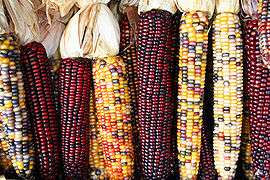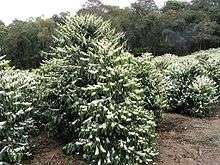Agricultural history of Peru
Much of the pre-history of Peru has been wrapped up in where the farmable land was located. The most populated coastal regions of Peru are the two parallel mountain ranges and the series of 20 to 30 rivers running through the coastal desert. In dry periods only the mountains are wet enough for agriculture and the desert coast is empty, while in wet periods many cultures have thrived along the rivers of the coast. The well known Inca were a mountain-based culture that expanded when the climate became more wet, often sending conquered peoples down from the mountains into unfarmed but farmable lowlands. In contrast, the Moche were a lowland culture that died out after a strong El Niño, which caused abnormally high rainfall and floods, which was followed by a long drought.[1]
A study has shown that the crops of squash, peanuts, and cotton were domesticated in Peru around 10,000, 8,500, and 6,000 years ago, respectively. They were grown by the Ñanchoc people in the Ñanchoc Valley. No earlier instances of the farming of these crops are known.[2]
Peru is both afflicted and blessed by a peculiar climate due to the Humboldt Current. Before overfishing killed its fishery, Peru had the most productive fishery in the world due to the cold Humboldt Current. The current brings nutrients from a large portion of the Pacific floor to Peru's doorstep. On land, it results in a cold mist that covers coastal Peru to the extent that the desert plants have adapted to obtain water from the air instead of from the infrequent rainfall. The soil on the wet side of the mountains is thin, and the rivers on the dry side are few. This means all the water must be brought from the Atlantic side of the mountain ranges that split Peru.
There were many obstacles to improving Peru's agricultural production. Since the conquest of the Inca, Peru has always been rich in natural resources such as tin, silver, gold, guano and rubber. These resources share the attribute that, at least in Peru, they were found, not grown. The train tracks laid in Peru did not connect its peoples, they connected the sources of these valuable resources to the sea. So there are few ways to bring agricultural products to market. The road system is still primitive in Peru, there is no connection to Brazil and only a little over a quarter of the 15th-century Inca road system has been rebuilt as modern highway. Another obstacle is the size of Peru's informal economy. This prevents Peru from practically applying an income tax, which means much of its revenue comes from a 13% tax on gross agricultural sales. This means Peruvian farmers must produce that much more product per dollar just to break even with farmers in countries that tax farmers on net profit. They have no chance at all of competing with agricultural products from countries that subsidize farmers, such as Japan, the United States and Europe.
Today Peru grows agricultural commodities such as asparagus, potatoes, maize, rice, and coffee.[3] Peru provides half of the world supply of quinoa.[4] Peruvian agriculture uses synthetic fertilizers rather than the still-abundant guano due to infrastructure issues. The maize is not exportable due to large subsidies in Europe and the United States to its high-cost producers, but coffee is exportable. In recent years Peru has become the world's primary source of high-quality organic coffee.[5] Peru does not have a quality control program such as Kenya's but its government has worked to educate farmers on how to improve quality. Despite the glut of coffee producers in the market today, coffee production in Peru is still promising. It naturally has the high altitudes and partial shade desired by Coffea arabica, and it has much more of such land available than competitors such as Jamaica and Hawaii.
Aqueducts and terraces
The ancient people of Peru built water-moving and preserving technologies like the aqueducts of Cumbe Mayo (c. 1500 BCE) or the Nazca's underground aqueducts called Puquios (date uncertain), or the terraced gardens of the Huari. Aqueducts were also utilized by the Moche.[6]
Another technique used to adapt the steep land of the Andes Mountains for farming was through terracing. The Chavin,[7] the Moche,[6] and the Incas built terraces, or flattened areas of land, into the sides of hills. The terraces reduced soil erosion that would normally be high on a steep hill. These terraces are still used in Peru.[8] The Incans also irrigated their fields with a system of reservoirs and cisterns to collect water, which was then distributed by canals and ditches.[9]
However, by the mid-19th century, only 3% of Peru's land was still farmable. It lagged far behind many other South American countries in agriculture.
Peruvian guano
In the 19th century the Inca fertilizer guano (saltpetre) became the most important resource in Peru's modern history, both for its use as a fertilizer and as firepowder.[10] A remarkably ideal habitat and climate in Peru's guano islands allowed the supply of guano to build up over hundreds of years. The nutrient rich Humboldt Current of the coast of Peru once drew thousands of anchovies and other fish, which in turn, attracted thousands of birds. The population of white-breast cormorants, gray pelicans, and piqueros flourished due to a lack of predators. The guano, or bird droppings, the birds left behind was able to retain its nitrate content because of the arid climate.[11] Between 1840 and 1880, Peru sold around 20 million tons of guano, at the rate of hundreds of thousands of tons per year, mostly to Great Britain. Peru earned about 2 billion dollars in profit.
But Peru lost its guano reserves to Chile (backed by the British Empire) in the War of the Pacific.[12] By the late 19th century, 50% of the Peruvian government's revenue was going to pay off loans that been guaranteed with guano sources that Peru lost to Chile - these debts were eventually paid by sending all the remaining guano to France when they were preparing for war. The Germans invented the Haber process shortly after the outbreak of World War I, after which guano became almost worthless.
The remainder of Peru's guano reserves was running out. The government responded by restricting the guano industry to help stabilize the guano supply. The collapse of Peru's bird population after the collapse of the fishery also limits future supply of the fertilizer.[10]
Peruvian agricultural products
-

Potato plants
-

Maize ears
-

Rice field
-

Rice plants
-

Flowering coffee tree
References
- ↑ Davidson, Nick "Lost society tore itself apart". BBC News. Retrieved 17 January 2010.
- ↑ "Peanuts, cotton, squash first farmed in Peru 6,000-10,000 years ago" Archived January 7, 2010, at the Wayback Machine.. Mongabay.com. Retrieved 7 January 2010.
- ↑ "Peru". The CIA World Factbook. Retrieved 7 January 2010. (Look under section "Economy")
- ↑ "FAOSTAT". Food and Agriculture Organization of the United Nations Statistics. Retrieved 2013-04-12.
- ↑ "Peru: Organic Products Update 2008". USDA Foreign Agricultural Service Global Agriculture Information Network. Retrieved 7 January 2010.
- 1 2 Sayer, page 10.
- ↑ Wood, page 4.
- ↑ Sayer, page 25.
- ↑ Wood, page 18.
- 1 2 Leonard, Andrew."When guano imperialists ruled the earth". Salon.com. Retrieved 7 January 2010.
- ↑ "ICE Case Studies: Guano Wars". The Inventory of Conflict & Environment (ICE). Retrieved 7 January 2010.
- ↑ "War of the Pacific 1879-1884". Wars of the World*. Retrieved 7 January 2009.
General references
- Sayer, Chloë. The Ancient World: The Incas. Austin: Raintree Steck-Vaughn, 1999.
- Wood, Tim. See Through History: The Incas. New York: Viking, A Division of Penguin USA, 1996.